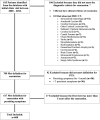Cause of Concussion With Persisting Symptoms Is Associated With Long-Term Recovery and Symptom Type, Duration, and Number in a Longitudinal Cohort of 600 Patients
- PMID: 38468550
- PMCID: PMC11707678
- DOI: 10.1089/neu.2023.0263
Cause of Concussion With Persisting Symptoms Is Associated With Long-Term Recovery and Symptom Type, Duration, and Number in a Longitudinal Cohort of 600 Patients
Abstract
It is important for patients and clinicians to know the potential for recovery from concussion as soon as possible after injury, especially in patients who do not recover completely in the first month and have concussion with persisting concussion symptoms (C+PCS). We assessed the association between the causes of concussion and recovery from C+PCS in a consecutive retrospective and prospective cohort of 600 patients referred to the Canadian Concussion Center (CCC) at Toronto Western Hospital. Data were obtained from clinical records and follow-up questionnaires and not from a standardized database. A novel method was used to assess long-term recovery, and multi-variable Cox proportional hazards models were used to assess relationships between cause of concussion and time to recovery. We examined the subsequent recovery of patients who had not recovered after at least one month from the time of concussion. Patients were grouped into the following four causes: sports and recreation (S&R, n = 312, 52%); motor vehicle collisions (MVC, n = 103, 17%); falls (n = 100, 17%); and being struck by an object including violence (SBOV, n = 85, 14%). The MVC group had the highest percentage of females (75.7%), the oldest participants (median: 40.0 [interquartile range (IQR):30.5-49.0] years), the most symptoms (median:11.0 [IQR:8.5-15.0]), and the longest symptom duration (median: 28.0 [IQR:12.0-56.00] months). In contrast, the S&R group had the highest percentage of males (58.1%), the youngest participants (median:20.0 [IQR:17.0-30.0] years), the best recovery outcome, and shortest symptom duration (median:22.0 [IQR:8.0-49.5] months). Significant differences among the four causes included age (p < 0.001), sex (p < 0.001), number of previous concussions (p < 0.001), history of psychiatric disorders (p = 0.002), and migraine (p = 0.001). Recovery from concussion was categorized into three groups: (1) Complete Recovery occurred in only 60 (10%) patients with median time 8.0 (IQR:3.5-18.0) months and included 42 S&R, 7 MVC, 8 falls, and 3 SBOV; (2) Incomplete Recovery occurred in 408 (68.0%) patients with persisting median symptom time of 5.0 (IQR:2.0-12.0) months; and (3) Unknown Recovery occurred in 132 (22.0%) patients and was because of lack of follow-up. In summary, the cause of C+PCS was associated with the type, number, and duration of symptoms and time required for recovery, although all causes of C+PCS produced prolonged symptoms in a large percentage of patients, which emphasizes the importance of concussions as a public health concern necessitating improved prevention and treatment strategies.
Keywords: concussion causes; persisting symptoms; recovery.
Figures





Similar articles
-
Surveillance for Violent Deaths - National Violent Death Reporting System, 50 States, the District of Columbia, and Puerto Rico, 2022.MMWR Surveill Summ. 2025 Jun 12;74(5):1-42. doi: 10.15585/mmwr.ss7405a1. MMWR Surveill Summ. 2025. PMID: 40493548 Free PMC article.
-
Nightly Sleep Duration and Symptom Burden Over 1 Month Following Pediatric Concussion.JAMA Netw Open. 2025 Jun 2;8(6):e2516333. doi: 10.1001/jamanetworkopen.2025.16333. JAMA Netw Open. 2025. PMID: 40531535 Free PMC article.
-
Factors Associated with Persisting Post-Concussion Symptoms Among Collegiate Athletes and Military Cadets: Findings from the NCAA-DoD CARE Consortium.Sports Med. 2025 Jul;55(7):1743-1755. doi: 10.1007/s40279-024-02168-0. Epub 2025 Jan 19. Sports Med. 2025. PMID: 39828869
-
A narrative review of risk factors and predictors for poor outcome and prolonged recovery after a mild traumatic brain injury.Int J Neurosci. 2025 Jul;135(7):761-770. doi: 10.1080/00207454.2024.2328710. Epub 2024 Mar 13. Int J Neurosci. 2025. PMID: 38465501 Review.
-
Factors Associated With Persisting Symptoms After Concussion in Adults With Mild TBI: A Systematic Review and Meta-Analysis.JAMA Netw Open. 2025 Jun 2;8(6):e2516619. doi: 10.1001/jamanetworkopen.2025.16619. JAMA Netw Open. 2025. PMID: 40531530 Free PMC article.
Cited by
-
Analysis of Concussions with Persisting Symptoms Caused by Motor Vehicle Crashes in 136 Vehicle Occupants Shows that Females Are Vulnerable Road Users.J Neurotrauma. 2025 Jun;42(11-12):916-928. doi: 10.1089/neu.2024.0207. Epub 2024 Nov 27. J Neurotrauma. 2025. PMID: 39605201 Free PMC article.
-
Diagnosis and Management of Mild Traumatic Brain Injury (mTBI): A Comprehensive, Patient-centered Approach.Curr Pain Headache Rep. 2025 Jan 8;29(1):19. doi: 10.1007/s11916-024-01333-4. Curr Pain Headache Rep. 2025. PMID: 39776286 Free PMC article. Review.
References
Publication types
MeSH terms
LinkOut - more resources
Full Text Sources
Medical
